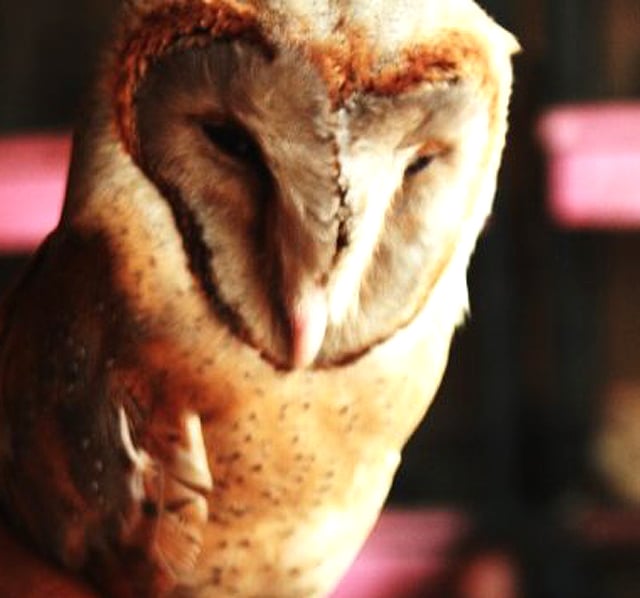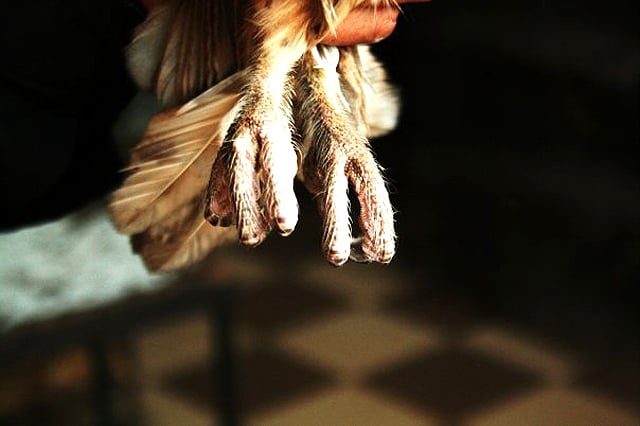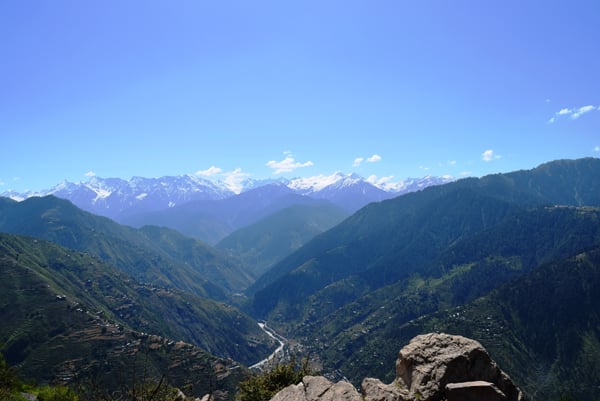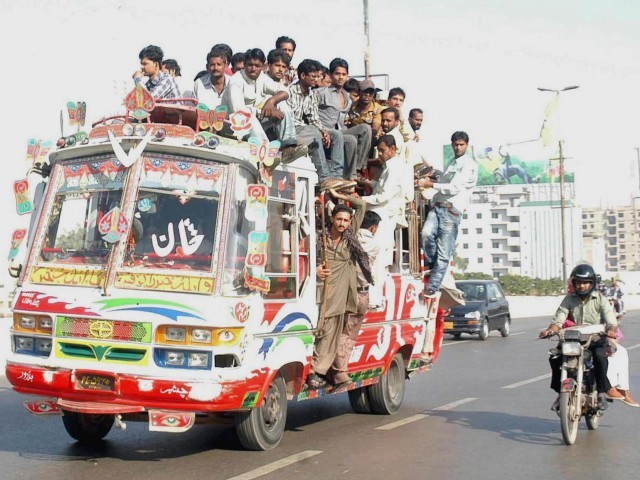This mafia-handled system consists of sub-standard coaches and minibuses, operated and under the complete ownership of private businessmen.
The population of Karachi is around 16.62 million currently and is said to increase to 27.5 million by 2020, according to KMC estimates. Karachiites make around 24.2 million trips via public transport on an average weekday. As per data collected in 2012, there are 12,399 permit-holding buses currently operational in Karachi (the term ‘buses’ here includes all large transportation vehicles, such as normal buses, mini buses and coaches – each of which have 26 seats on average). If you include the number of vehicles that operate without legal permit, then the amount increases.
Keeping the permit figure in mind, we can estimate that there is one bus for every 1,171 people and 45 passengers per bus seat in Karachi. These tightening figures must give you an idea of what a struggle it is for the common Karachiite to commute from one place to another on a daily basis. It would also explain the overflowing buses you might have seen on the roads with people either hanging by the doors or sitting on the rooftop, putting their lives in danger.
 Stock Image
Stock ImageThe sad part is that an absence of any other alternate affordable mode of transportation forces us to travel under these circumstances. You will find more room for chickens in a poultry truck if compared with the space restrictions faced by humans on these buses.
On top of that, there is no consistency in the schedule of these buses. Your bus might arrive before its scheduled time or an hour later; there are just no checks in place. Transporters decide how many buses will operate on any given day and citizens have no choice but to adjust accordingly. If CNG is closed on a particular day, the number of buses are reduced to save money, which ultimately results in a huge number of people not being able to travel.
‘Fare’ weather friend
Private bus owners rarely abide by notifications or orders that ask them to decrease fares. In fact, they hardly ever follow government directives and there is no standard formula defined to decide bus fares. Karachiites are supposed to pay whatever fare the owners have decided – otherwise they can get off the bus and sit at home. Fares always increase when fuel prices increase; however, the same doesn’t happen when fuel prices drop.
Because of this, fare-related disputes between passengers and conductors are pretty common. If you travel 10 times on a public bus, chances are you’ll come across fare-related fights at least nine times – I guarantee that. Since neither a static formula nor a predefined platform to decide fares exists, passengers often complain that they are being charged unjustly. But conductors and drivers never accept this.
On an average, one-way fare per passenger for a bus is Rs20/- (regardless of whether you are sitting, standing or hanging) with room for 26 passengers to sit; however, there are often more than double the number of passengers on-board, who are either standing inside or hanging from the door or sitting on the rooftop. For argument’s sake, we can conclude that at least 40 passengers are on board in a bus at any given time.
This means that a single bus collects Rs800 for a single one-way trip in a day; which means that 12,400 buses collect around Rs9.9 million for a single trip! If we estimate that a bus makes at least 10 trips, the figure becomes Rs99.2 million. This is what private bus owners earn in a single day, which is quite a hefty amount! So it’s clear that public transports rarely go into losses; why then are owners adamant when it comes to decreasing or changing fares?
 Photo: Sajjad Hashmi
Photo: Sajjad HashmiAs no official data is present regarding this, and the basic data used for calculations is collected from various sources, a variation in the figures can be expected – but the overall picture will remain the same.
Misbehaving with the passengers
Most bus drivers and conductors are uneducated. They become a part of this mafia from an early age and are unable to get any education. Hence, they don’t have any manners about how to deal with the public. They often misbehave with passengers over petty issues, such as taking fares or asking them to snug in (if they are standing) so room can be made for more passengers. They often push and shove passengers inside, without any regard whatsoever.
Above all, their behaviour with female passengers should be condemned. In Karachi, buses are supposed to have a separate section in front, only for women, but conductors often allow men to ride in that section as well. They misbehave with women regularly; cussing and catcalling is a usual phenomenon; fights often erupt between passengers and conductors (or drivers) over some snide remark made by them.
I remember this one time when the conductor went into the women’s section, even though it was full, under the pretence of collecting fares. The women started complaining that the conductor was trying to grope and touch them, and was purposely brushing himself against them. The issue escalated and people from the men’s section also joined the protest; the verbal dispute soon turned into a physical one and the bus couldn’t continue its journey further.
While the protest saved many women from getting harassed by that conductor, the thought that he had such audacity made me very uncomfortable about travelling in a public bus.
Security
Since these buses are not owned by any government authority, they pose a danger to citizens at various levels. Most drivers are not trained to drive large vehicles; in fact, often underage boys are seen driving. These drivers have no knowledge of traffic rules or conduct. They often over-speed and overtake other vehicles in a very reckless manner. This puts in danger not only the lives of its passengers but also of those people who are on the road.
These irresponsible and inexperienced drivers are to blame for most of the road accidents that take place in Karachi, making Karachi’s roads one of the most dangerous to commute on.
More than a 1,000 people lose their lives in Karachi every year due to road accidents and more than 35,000 accidents occur annually, leaving many injured or disabled.
Beside these dire consequences, this system has also been giving rise to many major conflicts in the city. The Bushra Zaidi case is monumental in this regard, where a road incident led to the start of ethnic riots resulting in 50 casualties with 300 people injured within a week! Since then, there exists a strong divide in this city over particular ethnic lines and all this hatred has roots in this transportation system.
 Photo: Sajjad Hashmi
Photo: Sajjad HashmiAnother rising concern is the illegal usage of low quality cylinders for CNG. These cylinders are usually meant for general usage and not made for high pressure CNG usage. They are fitted in the passenger area of the buses, putting the lives of commuters in great danger.
These overly-filled buses are hardly stopped by law enforcement agencies (LEAs) during snap-checking, as it is not practically possible to stop each of them and check everyone in and out. Also, since they are not regulated by any government agency, their monitoring practically becomes impossible, which makes them a security risk; the perfect camouflage for terrorists to travel form one point to other within a city or even smuggle weapons and other illegal material, like drugs, throughout Karachi.
Time to commute
These buses stop regularly at random stops, resulting in road jams, and they often wait longer than usual on stops where there aren’t many passengers on-board. This increases the overall travel time for passengers and also make it uncertain for them to calculate their estimated time of arrival.
This has also affected the traffic patterns in Karachi. Due to the deteriorating condition of this system, many people try to get their own means of transport as soon as they are able to afford it. As a result, we find more vehicles on the roads and the roads becomes congested. This leads to a collapse of the traffic flow, especially during peak hours, where the commute time almost doubles.
Monopoly
Keeping the government aside, even the transport mafia doesn’t do any good for the citizens. Neither do they make their own services better nor do they let alternative transport systems grow in this city. They just have their own monopoly, which they wish to maintain no matter what.
One example of this is the green bus. When the standardised, comfortable CNG green buses were introduced by Mustafa Kamal (former mayor) in Karachi, the buses and their stations were attacked and were also criticised on an official level by representatives of the transporter mafia sitting in the Sindh Assembly.
In 2009, the transport minister of the time – who was also part of the transport mafia – said, with regards to the green buses initiative, that:
“CDGK’s job is to clean drains, not to run transport for citizens.”
However, Mustafa Kamal kept his efforts going to keep these buses on the roads as long as he was in charge, but as soon as he left, so did the buses. The remaining buses were recently ‘re-launched’ by the Sindh government after changing their name to SMBB Bus Service. They are the same as far as the appearance is concerned but they are now being operated just like all other public bus.
The Karachi Mass Transit Plan (1987-1991), Karachi transport improvement project (KITP-2009), circular railway service in Karachi and Karachi mass transit project too have faced the same fate.
The same transport mafia has also been blamed for influencing the bans over pillion riding and Qingqi rickshaws in the city. One might argue the Qingqi rickshaws are also not a suitable mode of transportation, but for the citizen of Karachi, these rickshaws in which they can travel by sitting comfortable, are a blissful alternative compared to travelling like animals in these public buses.
Seeing their popularity, the transporter mafia has been trying to pressurise the government to ban these rickshaws from day one. A recent example is when the transporters announced that they will only reduce the fares by one rupee, and that too once the government bans these rickshaws. These were the exact words used:
“The KTI has made it conditional for the minister to ban the Qingqi if he wants the transporters to decrease the bus fares.”
What do you expect in a city where ministers take such strict “directions” from the ones they are supposed to regulate? This is a prime example of how audaciously this mafia operates in this city.
 Photo: Sajjad Hashmi
Photo: Sajjad HashmiThe road ahead
We, as citizens, and the government need to own Karachi as our city – only then will we ever be ready to understand this issue and work on finding a solution. Karachiites need to unite, albeit if they travel via buses or not, and stand up against this mafia which is devouring our roads and our civic rights.
Karachi’s problem can only be understood and resolved if its administration and government is done by those who live here and have been affected by the aforementioned issues. When elected representatives from this very city will handle its transport, they will have to make sure that they keep it as per the public demands or the public will reply back in the form of their voting power.
For a start, the government should foremost re-launch the circular railway and metro projects in Karachi and the City District Government should be made responsible for these. It should also start its own bus system comprising of standard buses operating over seat-by-seat basis with pre-decided fares, timings and routes.
Furthermore, LEAs in the city should be directed to keep an eye out for criminal elements who would surely try to dismantle these projects through various conspiracies and nobody should be allowed to blackmail the government or create hurdles in the path of these development projects. The transport minister should not be someone who has his own stakes in it or else he’ll always keep the mafia first and the city second.
A strong political will and hard-core action is needed to take down this 50-year strong mafia in Karachi and set citizens of Karachi free from these shackles, giving them a lifestyle which may not be luxurious but at least humane enough for them to live peacefully in.
The time to act is now. Don’t let the mafia rule over you and treat you like animals anymore.



COMMENTS
Comments are moderated and generally will be posted if they are on-topic and not abusive.
For more information, please see our Comments FAQ